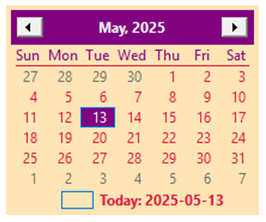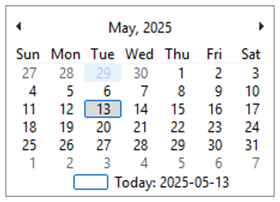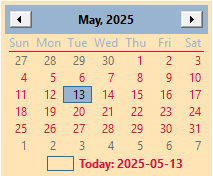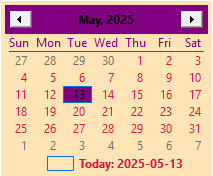
|
How to Create a .NET Calendar Control (Program) |
Starting with PxPlus 2025, a .NET Interface was added to PxPlus that allows for the creation of .NET objects in your application.
For this example, you will be creating a .NET MonthCalendar control in a program. You will be adding various properties (i.e. color and text) and creating an event when a date is selected using the new interface.

Properties and Event of the .NET MonthCalendar
The .NET MonthCalendar is associated with various properties that allow you to customize its appearance and behavior. For this tutorial, you will be shown just a few of the many possibilities that are available when using properties.
This table lists the properties and the event for the .NET MonthCalendar you will be creating.
|
Object/Property |
Description |
|
BackColor |
Background color of the calendar. |
|
ForeColor |
Color of the calendar dates. |
|
TitleBackColor |
Gets or sets a value indicating the background color of the title area of the calendar. |
|
TitleForeColor |
Adds the text color of the title and today's date or a selected date on the calendar. |
|
MaxSelectionCount |
Allows the number of days to be selected at the same time. |
|
Event |
Description |
|
DateSelected |
Event triggered by a selected date or range of dates. |
On the Command line, define a MonthCalendar object.
Syntax:
def object net_calendar,@(30,10,33,12),"[.NET]System.Windows.Forms,System.Windows.Forms.MonthCalendar"

These steps show you how to customize the appearance of the .NET MonthCalendar.
|
1. |
You will create three additional objects and set the background color. The Application object has methods to start and stop applications and threads, and to process Windows messages. It allows access to the VisualStyleState object below. Syntax: def object app,"[.NET]System.Windows.Forms,System.Windows.Forms.Application" The VisualStyleState object specifies how visual styles are applied to the current application. The property needed for the calendar style will also be needed in the program. For this example, you will only apply visual styles to the calendar (nonclient area); otherwise, this property will affect all windows controls. Syntax: def object vis,"[.NET]System.Windows.Forms,System.Windows.Forms.VisualStyles.VisualStyleState" |
|
2. |
Define a Color object to change the appearance of the calendar. Syntax: def object color,"[.NET]System.Drawing,System.Drawing.Color" |
|
3. |
Set BackColor$ for the background color of the calendar. For this example, the background color will be Moccasin. The PvxHandle$ property is used for assigning or passing in a .NET object to a .NET object constructor, property or method. Syntax: net_calendar'BackColor$=color'Moccasin'pvxhandle$ |
When setting colors, you also have the option to use RGB colors.
For this example, you will be using the RGB code for the color Crimson, which is RGB: 220 20 60.
Syntax:
net_calendar'ForeColor$=color'FromArgb(220,20,60)'pvxhandle$

This step shows you how to set the TitleBackColor for the background color of the calendar title area.
For this example, you will be using the color Purple.
Syntax:
net_calendar'TitleBackColor$=color'Purple'pvxhandle$

This step shows you how to set the TitleForeColor for the text in the calendar title and today's date.
For this example, you will be using the color White.
Syntax:
net_calendar'TitleForeColor$=color'White'pvxhandle$

These steps show you how to set the maximum number of days that can be selected.
|
1. |
To force the maximum number of days that can be selected, set MaxSelectionCount=17. (Setting a value of 17 will allow the user to select 17 days as the date range.) Syntax: net_calendar'MaxSelectionCount=17 |
|
2. |
Before going any further, enter START on the Command line to drop all objects. |
To create the calendar programmatically, you will need to create a program to run.
For this example, you will be creating and naming the program: dotnet_calendar
|
1. |
Copy and paste the following lines of code into a program to be executed. ! dotnet_calendar - .NET calendar programmatically
|
|
2. |
Save the program as: "dotnet_calendar" |
|
3. |
Run the program. |
|
4. |
The calendar will display on the screen. A maximum of 17 days may be selected. The program will wait for input, at the WHILE/WEND loop, until the dialog is exited via the X (Close button) in the top right corner. |
Events are functions of the calendar that will be performed when something happens in the .NET control.
For this example, the DateSelected event of the .NET MonthCalendar control will be used.
How to Define an Event to Show a Message Box
These steps show you how to define an event to show a message box when the user selects a date or date range from the calendar.
|
1. |
Load the dotnet_calendar program and insert these lines prior to the WHILE/WEND loop: Syntax: DateSelected=new("CalSelection") |
|
2. |
Save and close the program. |
|
3. |
To select and show a single date or date range, create an object program for the main program to invoke with the lines of code shown below. This program must be called CalSelection.pvc and be saved in the same directory as the main program. Insert these lines and save the program: def class "CalSelection"
|
|
4. |
Save and close the program. |
|
5. |
Reload and run the dotnet_calendar program. |
|
6. |
Selecting a date range results in a message box displaying the date range selected. |
|
7. |
Selecting a single date results in a message box displaying the date selected. |
These steps show you how to clean up any objects that were defined.
|
1. |
Insert these lines before the END command: drop object color,err=*next |
|
2. |
Save the program in the editor. |
At the end of this tutorial example, you should have a working program similar to the one below:
! dotnet_calendar - .NET calendar programmatically
!
! Create and initialize the Calendar
def object net_calendar,@(60,20,33,12),"[.NET]System.Windows.Forms,System.Windows.Forms.MonthCalendar"
def object app,"[.NET]System.Windows.Forms,System.Windows.Forms.Application"
def object vis,"[.NET]System.Windows.Forms,System.Windows.Forms.VisualStyles.VisualStyleState"
app'visualstylestate=1 ! Visual styles are applied only to the nonclient area.
def object color,"[.NET]System.Drawing,System.Drawing.Color"
!
! Define the object for Color
net_calendar'backcolor$=color'moccasin'pvxhandle$ ! background color of the calendar.
net_calendar'forecolor$=color'crimson'pvxhandle$ ! text color used to display the days of the month.
net_calendar'titlebackcolor$=color'purple'pvxhandle$ ! background color of the title area (month and year).
net_calendar'titleforecolor$=color'white'pvxhandle$ ! text color of the title area.
net_calendar'maxselectioncount=17 ! max num days that can be selected in a single range !
!
dateselected=new("CalSelection")
on event from net_calendarprocess dateselected
!
while 1
obtain (0,siz=1)'ME',*,'MN'
if ctl=-1999 \
then break
wend
!
drop object color,err=*next
drop object app,err=*next
drop object vis,err=*next
drop object dateselected,err=*next
drop object net_calendar,err=*next
!
end
!
def class "CalSelection"
!
function dateselected(sender,evtargs)DATESELECTED for event "DateSelected"
end def
!
DATESELECTED:
enter sender,evtargs
fd$= evtargs'start'toString$("dd MMM yyyy")
td$= evtargs'end'toString$("dd MMM yyyy")
if fd$<>td$ \
then \
{ ! fd$>td$ more than 1 date was selected
msgbox "From Date: "+fd$+sep+"To Date: "+td$,"Date Range Selection"
return
}
msgbox "Date Selected: "+fd$,"Date Selection"
!
return
.NET Interface
How To Tutorials (for .NET Interface)
DEF OBJECT Define Windows Object
ON EVENT Event Processing